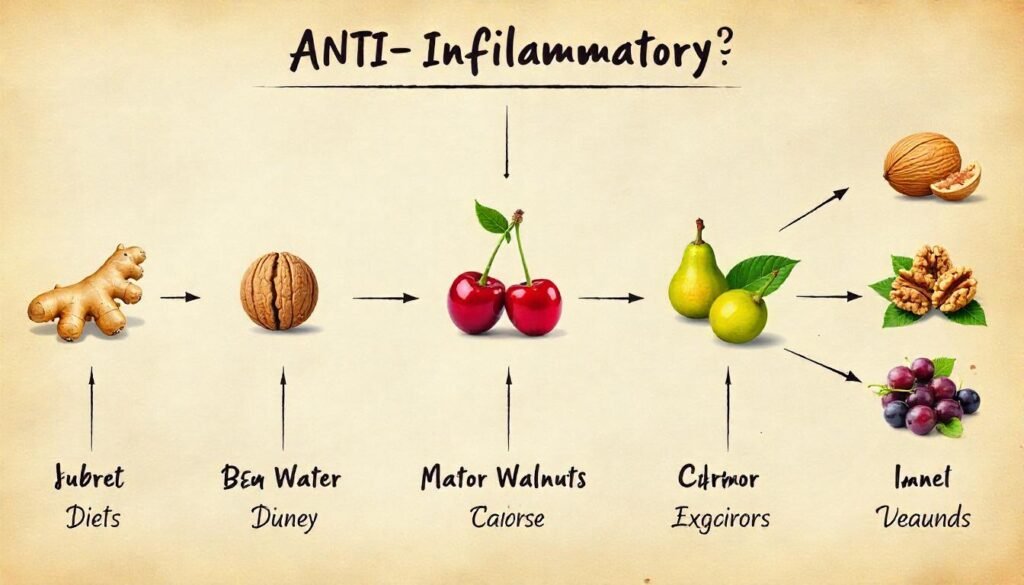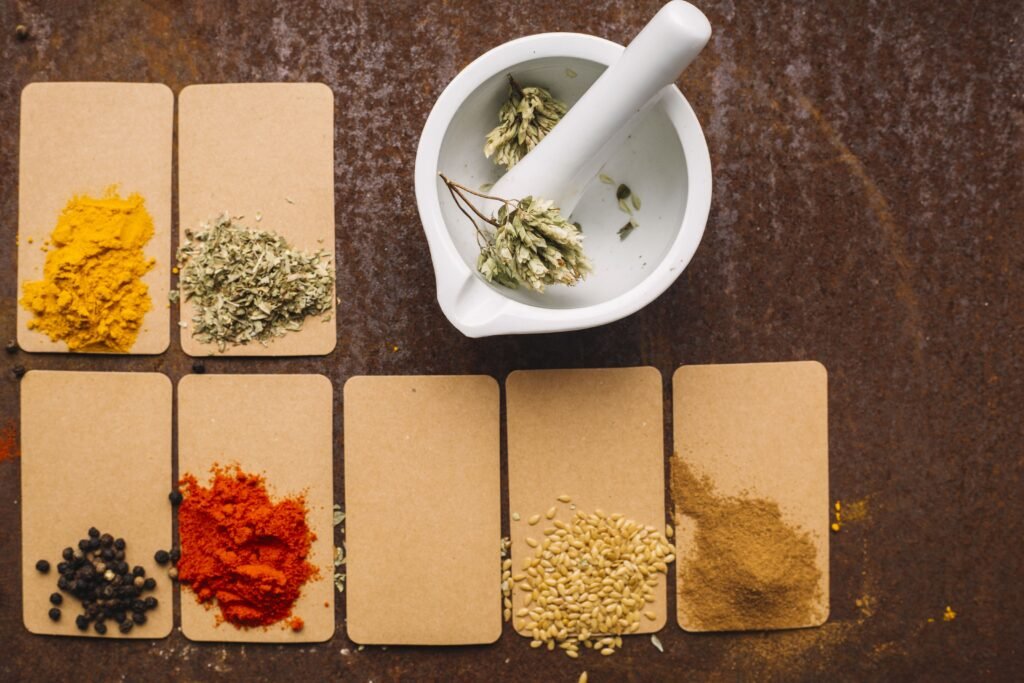Over the past few years, I’ve struggled with occasional bloating, discomfort, and the mental fog that comes with a less-than-happy gut. Through trial and error—and with the guidance of integrative nutritionists—I discovered seven practical, science-backed ways to tame inflammation in the gut using food as medicine. In this post, I share my personal experiences, insights, and concrete strategies,
It can feel overwhelming when you first hear terms like “gut inflammation,” “leaky gut,” or “IBS symptoms,” especially if you’re new to healing your gut. I remember scrolling online at 2 a.m., trying to find the “perfect” gut health meal plan for hormone balance or a “probiotic-rich foods” list, only to feel more confused. My goal here isn’t to present an abstract lecture; instead, I want to guide you, step by step, through seven actionable approaches that worked for me, with straightforward tips you can implement immediately—whether you’re seeking a “gut healing diet for beginners” or looking to fine-tune your “nutrition for post-antibiotic gut recovery.”
Table of Contents
Why Gut Inflammation Matters (Personal Perspective)

When I first experienced persistent stomach aches and gas after meals, I shrugged it off as “just stress” or “something I ate.” But when a road trip turned into a race to the nearest restroom, I realized gut inflammation wasn’t something to ignore.
- Understanding Gut Inflammation
At its core, gut inflammation is your body’s response to something—food, stress, or infection—that it perceives as a threat. The lining of your intestines becomes more permeable (“leaky gut”), allowing toxins or undigested particles to slip through. This can trigger immune reactions, discomfort, and long-term health issues like IBS, eczema, or even mood disturbances. - Why It’s Critical to Address Early
Left unchecked, gut inflammation can evolve into chronic issues. You might notice brain fog, food sensitivities, joint pain, or recurrent skin issues. For me, my normally energizing morning jogs turned into sluggish plods because my gut was working against me, stealing my energy through constant inflammation. - The Role of Diet
While genetics play a part, diet is often the first and most potent lever you can pull. Adopting a low-FODMAP diet temporarily helped ease my bloating, but I soon learned that eliminating triggers alone wasn’t enough. I needed to rebuild my gut lining, nurture healthy bacteria, and incorporate foods specifically targeted at reducing inflammation. That’s where an anti-inflammatory diet came into play, and why focusing on whole foods rather than pills became my North Star.
By recognizing that digestive discomfort signals a deeper imbalance, I became motivated to experiment with different eating strategies—“the gut healing diet for beginners,” “meal plans for anti-inflammatory diets,” and “foods to improve digestion for IBS.” Below, I outline the seven methods that worked best for me.
1. Embrace Anti-Inflammatory Whole Foods

When I shifted from processed snacks to real, whole foods—vibrant fruits, lush veggies, and lean proteins—I noticed a dramatic reduction in bloating and gut discomfort. The key here isn’t just “clean eating,” but specifically choosing foods known to soothe the digestive tract and quell inflammation.
- Berries (Blueberries, Strawberries):
Rich in antioxidants like anthocyanins, berries combat oxidative stress in the gut lining. Whenever I felt a flare-up coming on, I’d whip up a smoothie packed with spinach (prebiotic fibers) and mixed berries. Tip: Freeze a batch of mixed berries in single-serve bags for quick, anti-inflammatory breakfasts. - Cruciferous Veggies (Broccoli, Kale, Cauliflower):
These vegetables contain sulforaphane and other sulfur-containing compounds that promote detoxification and support gut barrier integrity. I personally roast broccoli florets with a dash of olive oil, garlic, and black pepper—simple, delicious, and incredibly soothing for the digestive system. - Leafy Greens (Spinach, Swiss Chard):
High in magnesium and folate, these greens have a gentle laxative effect and nourish the intestinal lining. A handful of baby spinach in my scrambled eggs every morning set me up for smoother digestion all day. - Colorful Vegetables (Bell Peppers, Carrots, Beets):
Vibrant colors often signal high polyphenol content. Polyphenol-rich foods like carrots and beets feed beneficial bacteria and reduce gut inflammation. My go-to is a rainbow salad tossed with beets, carrots, arugula, and a lemon-tahini dressing. - Extra Virgin Olive Oil (EVOO):
A staple of the Mediterranean diet, EVOO contains oleocanthal, a natural anti-inflammatory agent. I drizzle it over mixed greens or use it to lightly sauté vegetables. - Omega-3 Rich Foods (Salmon, Mackerel, Chia Seeds, Flaxseeds):
Omega-3 fatty acids lower pro-inflammatory cytokines in the gut. On weekends, I prepare baked salmon with a flank of lemon and fresh dill. If fish isn’t your favorite, try blending chia seeds into your morning smoothie or sprinkling ground flaxseeds on oatmeal. - Avocados and Nuts (Walnuts, Almonds):
Avocados offer monounsaturated fats and fiber, while walnuts deliver alpha-linolenic acid (ALA), a type of omega-3. One of my favorite snacks is apple slices topped with mashed avocado and a sprinkle of hemp seeds - Collagen-Rich Sources (Bone Broth, Gelatin):
Collagen supports gut lining repair. I stock up on homemade bone broth (chicken or beef) and sip it throughout the day—an ancient remedy. - Fatty Fish and Pasture-Raised Chicken:
These proteins are easier to digest than red meat, reducing gut irritation. When I meal prep chicken, I marinate it in turmeric and ginger—two powerful anti-inflammatory spices. - Plant-Based Proteins (Lentils, Chickpeas, Tofu):
If you follow a vegetarian or plant-based path, ensure proper preparation (soaking beans overnight to reduce lectins) and include prebiotic fibers. A chickpea curry with turmeric, ginger, and garlic became my favorite way to soothe gut inflammation on chilly evenings.
Sample Anti-Inflammatory Meal Plan
- Breakfast: Smoothie (spinach, mixed berries, chia seeds, a scoop of collagen peptide powder, water/almond milk)
- Mid-Morning Snack: Handful of walnuts + a small apple
- Lunch: Salad (mixed greens, beets, carrots, cucumbers) topped with grilled salmon, avocado slices, and a lemon-EVOO dressing
- Afternoon Snack: Baby carrots with hummus (ensure hummus is tahini- and garlic-based, not heavy on additives)
- Dinner: Roasted chicken marinated in turmeric, garlic, and olive oil, served with steamed broccoli and quinoa
- Pre-Bed Sip: Warm cup of bone broth
This “meal plans for anti-inflammatory diets” template became my blueprint. In just two weeks of consistent eating, I noticed less bloating, improved energy, and far fewer cravings for processed foods—confirming that anti-inflammatory whole foods were foundational to reducing gut inflammation.
2. Leverage Probiotics and Fermented Foods

One habit that revolutionized my gut health was intentionally incorporating probiotic-rich foods into my diet. Probiotics are live microorganisms that help restore balance to your gut microbiome. I’m not talking about random, expensive capsules—rather, simple, delicious fermented foods you can find at the grocery store or make at home.
Why Probiotics Matter
- Balance Gut Flora:
A diverse, balanced microbiome combats inflammation by preventing overgrowth of harmful bacteria. After a round of antibiotics, my gut microbiota was disrupted, leading to more inflammation and bloating. - Support Immune Function:
Up to 70% of your immune system resides in your gut. By fostering healthy bacteria, you indirectly bolster your immunity. I used to catch colds frequently, but once I added fermented foods, my immune resilience increased noticeably. - Enhance Nutrient Absorption:
Probiotics produce enzymes that help break down food and improve nutrient uptake, which in turn supports the gut lining’s integrity.
Top Probiotic Foods to Try
- Yogurt (Unflavored, Live Cultures):
I switched from flavored yogurts (packed with sugar) to plain Greek yogurt containing live cultures. To sweeten it, I add a teaspoon of raw honey or fresh berries. - Kefir:
A tangy, drinkable yogurt alternative that contains a broader spectrum of bacteria and yeast. I started my mornings with kefir smoothies (blend with banana, spinach, and a dash of cinnamon). - Sauerkraut and Kimchi:
These fermented cabbage dishes are staples in German and Korean cuisines, respectively. I buy an organic, unpasteurized version (so live cultures remain intact) and add a small side of kimchi to my rice bowls. - Kombucha:
A fermented tea beverage that is both refreshing and full of probiotics. I limit my kombucha intake to one glass per day to avoid excess sugar. - Miso:
A fermented soybean paste commonly used in Japanese miso soup. I prepare a simple miso soup (miso paste + water + tofu + scallions) a few times a week, which quickly became a comforting ritual. - Tempeh:
A fermented soybean patty that offers both probiotics and protein. I marinate tempeh in tamari, ginger, and garlic, then pan-sear it for a crispy, gut-friendly protein sources.
Personal Tips for Sticking with Probiotics
- Track GI Symptoms:
I kept a simple diary (on my phone) where I noted my gut symptoms each day—bloating, gas, stool consistency—especially before and after introducing a new probiotic. Within two weeks, patterns emerged: more yogurt equated to more regular bowel movements and reduced bloating. - Flavor Adjustments:
If you’re sensitive to tangy tastes, blend kefir with frozen mango and a sprinkle of cinnamon to mask the tang. For sauerkraut, I sometimes rinse it lightly to reduce sodium, then mix it into avocado toast or lentil salads. - Experiment with Different Brands:
Fermented foods vary widely by brand in terms of taste and potency. I tried three brands of kombucha before finding one that didn’t make me jittery (some have higher caffeine from tea). The key was to experiment and settle on what my gut liked best.
3. Adopt a Low-FODMAP or Elimination Approach (When Needed)

While whole, probiotic-rich foods form the bedrock of a gut-healing diet, some people (myself included, especially during flare-ups) find it helpful to temporarily reduce certain fermentable carbohydrates that feed gas-producing bacteria. This is where a low-FODMAP diet or targeted elimination approach can provide relief.
Incorporating Low-FODMAP Principles in Daily Life
- Use Garlic-Infused Oil Instead of Whole Garlic:
You get the savory garlic taste without the fructans that irritate your gut. - Choose Low-FODMAP Veggies:
Zucchini, bell peppers, carrots, and leafy greens are generally safe. I make stir-fries with these veggies and add protein for a balanced, gut-friendly meal. - Select Appropriate Fruits:
Berries (strawberries, blueberries), oranges, and unripe bananas are good choices. When I want an afternoon snack, I often reach for two kiwis or half a cup of blueberries. - Opt for Certified Gluten-Free Oats or Quinoa:
Many with gut inflammation find that gluten exacerbates their symptoms. I switched from wheat bread to a low-FODMAP bread (made from rice flour) and noticed significantly fewer flare-ups. - Experiment with Lactose-Free Dairy:
If you love yogurt or cheese, go for lactose-free Greek yogurt, which still provides protein and probiotics. I found a brand of lactose-free yogurt that contains live cultures—perfect for “gut healing diet for beginners.” - Monitor Sugar Alcohols:
Read labels carefully. Sugar-free candies or gums often contain sorbitol or xylitol, which can trigger symptoms. I replaced those small “diet” candies with dark chocolate (70% cocoa or higher) to minimize sugar alcohol exposure.
4.Prioritize Fiber—But Choose the Right Types
We often hear, “Eat more fiber,” but not all fiber behaves the same. Soluble fiber (which dissolves in water) forms a gel-like substance in the gut, helping to slow digestion, nourish beneficial bacteria, and reduce inflammation. Insoluble fiber (which adds bulk) can be great for regularity but may irritate a sensitive gut if introduced too quickly. I learned this the hard way when I tried a fiber supplement and ended up with more cramping.
High-Fiber, Low-FODMAP Foods
If you’re on a partial “low-FODMAP diet,” you can still get sufficient fiber. Some of my favorite high-fiber, low-FODMAP choices include:
- Oats (Certified Gluten-Free):
One cup of cooked oats has about 4 grams of soluble fiber. I make overnight oats soaked in almond milk with cinnamon, banana (if tolerated), and a dash of ginger. - Quinoa:
At 5 grams of fiber per cooked cup, quinoa is a complete protein and easy on the gut. I often substitute quinoa for rice to up my fiber intake. - Spelt Toast (in Moderation):
If you tolerate ancient grains, one slice of sprouted spelt or sourdough spelt bread can provide 2–3 grams of fiber. I top mine with avocado or almond butter. - Chia and Flaxseeds:
I blend 1–2 tablespoons into smoothies or make chia pudding. Both seeds are packed with soluble fiber that helps feed gut bacteria. - Carrots and Zucchini:
I spiralize zucchini into “zoodles” and lightly sauté them; carrots I slice into sticks for snacking. Both provide gentle insoluble fiber without menacing my sensitive gut.
6.Incorporate Specific Anti-Inflammatory Spices and Herbs

When I first embarked on my gut-healing journey, I underestimated the power of spices. A simple dash of turmeric can often outperform an expensive supplement. Below are the hero spices and herbs I added to my routine—and how they transformed my gut health.
Turmeric (Curcumin) for Gut Lining Support
- Anti-Inflammatory Mechanism:
Curcumin, the active compound in turmeric, inhibits pro-inflammatory pathways (e.g., NF-κB), reducing cytokines like TNF-α and IL-1β.
Ginger for Digestion and Gas Relief
- Anti-Inflammatory and Carminative Effects:
Ginger contains gingerols and shogaols, which reduce gut spasms and discourage gas-producing bacteria.
Cinnamon for Blood Sugar and Anti-Inflammation
- Mechanism:
Cinnamon contains cinnamaldehyde, which can modulate inflammatory pathways. By stabilizing blood sugar, cinnamon indirectly reduces gut inflammation (since blood sugar spikes can feed pathogenic gut bacteria).
6. Balance Macronutrients with Targeted Meal Planning
When I first started working on healing my gut, I focused a lot on which foods to remove. But over time, I learned that what you add to your plate is just as important. To feel your best and keep gut inflammation low, you need the right balance of macronutrients—that means protein, healthy fats, and carbohydrates. Getting the mix right can help your digestion, reduce blood sugar spikes, and give you steady energy throughout the day.
What Are Macronutrients?
- Protein helps repair tissues (including your gut lining) and keeps you full.
- Healthy fats reduce inflammation and help you absorb nutrients.
- Carbohydrates (especially the ones from whole foods) give you energy and feed the good bacteria in your gut.
Eating all three in the right balance at each meal made a big difference for me. I felt more satisfied, less bloated, and didn’t get those afternoon energy crashes.
Quick Tips to Make It Easier
- Don’t fear carbs, just choose whole ones—like oats, brown rice, or root veggies.
- Add healthy fats like olive oil, avocado, nuts, or seeds to keep your gut calm.
- Eat protein with every meal, even snacks—like boiled eggs, hummus, or Greek yogurt.
7. Mindful Eating and Stress Reduction
Even if you nail every dietary recommendation, chronic stress and distracted eating can perpetuate gut inflammation. By cultivating mindful eating habits and incorporating stress-relief practices, I discovered a powerful seventh pillar to my gut-healing approach.
Mindful Eating Strategies
- Designate a Mealtime Zone:
I now have a small corner in my home reserved for meals—no laptops, no phones. Before each meal, I take three slow breaths to transition from “work mode” to “eating mode.” - Chew Thoroughly and Slowly:
Science suggests chewing food 20–30 times per bite to enhance digestive enzyme activity. While it felt tedious at first, I noticed my bloating diminished once I slowed down. - Engage the Senses:
Take note of colors, textures, aromas, and tastes. This simple practice helps you feel more satisfied and signals to your brain that you’re truly eating, reducing overeating tendencies. I often close my eyes for a few seconds mid-bite to focus on flavor alone. - Pause Mid-Meal:
About halfway through my plate, I pause the fork, take a few deep breaths, and assess my satiety. This prevents mindless finishing of a plate and reduces undue stress on the gut. - Express Gratitude:
I learned to appreciate each meal—thanking the farmers, the cook, and my body’s ability to digest. This ritual shifted my relationship with food from “fuel” to “nourishment,” which I believe reduced my gut’s stress response.
Conclusion: Small Changes, Big Gut Relief
Improving gut health doesn’t have to be complicated. By making simple food choices—like adding more fiber, cutting out processed foods, and including anti-inflammatory ingredients—you can reduce gut inflammation and feel better day by day.
Start small. Choose one or two tips from this post and build from there. Over time, these little changes can make a big difference in your digestion, energy, and overall well-being.
Your gut can heal—and it starts with what you put on your plate.
